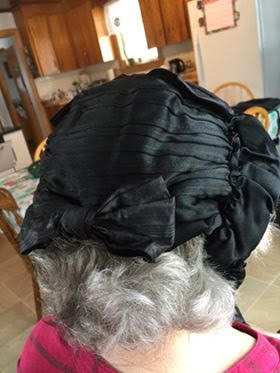Kashubian Ladies’ Cap Memory
Anne Pellowski
My great grandmother, Anna Kaizer Pellowski, came to the US in 1859. She brought with her only a few articles, but among them was a bonnet typical of the type Kaszubian women wear. I remember it as similar to the bonnets Dutch girls wore, in some of the books I was reading then as a child. The illustration shown here is similar to the bonnet that I remember. I think she may have brought a small piece of the pottery from the Lubiana pottery place where she worked before she married.
She arrived with her husband, Frank Pellowski on the ship Donau, Aug. 25, 1859. They were from Szwedzki Ostrow, a peninsula on Lake Wyrowno, near Lipusz. On that same ship were almost 100 other persons from Kaszubia, all heading in the same direction – Winona, Minnesota. There were several hundred other immigrants from Kaszubia, on ships arriving either in Quebec (the Elbe in 1859, the Franklin in 1869, the Gellert in 1860, the Oder in 1861) or in New York (the Laura in 1859, the Doretta in 1859, the Elise in 1860 and the Ancole in 1861). Virtually all were headed to Winona, or across the river, to the Dodge-Pine Creek area in Trempealeau County.
My great-grandmother Anna was pregnant, and caring for her infant son, who was sickly. He died about half-way through the voyage, and was buried at sea. Anna then began having labor pains and she bore her second son, Jacob, who became my grandfather. Jacob and his wife, Frances Zabinski eventually built a very imposing house. It was on the farm next to our farm. In his old age, Jacob asked his youngest daughter Sophia and her husband, Roman Dorawa, and their children, to live with him and his wife, Frances, who was bed-ridden by that time.
Jacob was the guardian of the few items that remained from those brought from Poland by Frank and Anna. They were brought out and displayed only on special occasions. I remember the special bonnet, trimmed with lace, that was said to denote that Anna was a married woman. There was also one item from Anna's time as a worker in the Lubiana pottery factory. (She had lost her parents when young, and had been indentured there.) There were some small embroidered pieces. My recollection is that there were four or five items in all.
My grandfather Jacob died when I was five years old, and I think the items were brought out at his wake in his home. My great-Aunt Anna died about five years later, and I believe the items were brought out again. When I was about 12, my aunt Sophia died of heart disease, and later the children all married and moved away, although staying close by. Roman was living alone in the house. The items had stayed in his house.
I was living in New York at the time and had not yet started writing my books. The first one, First Farm in the Valley, depicts the life of Anna and Frank and their family, as they settle into the life of relatively prosperous farmers in Latsch Valley, near Dodge and Pine Creek. I used my great-aunt Anna as the main character, rather than my grandfather, because I could identify better with a girl. The second book uses my mother as a main character and is set in the early 1900's, in the same valley. The third focuses on my childhood, from about 1938 to 1940, and the fourth has my niece Betsy as the main character, and is set in the late 1960's.
Perhaps if I had thought about writing these stories at that time, I might have asked to have the items so I could photograph and therefore preserve them. Regrettably, neither I nor anyone else thought of doing this.
Sadly, Uncle Roman seems to have fallen asleep and a fire started which burned the entire house. He died in the fire, so we not only had the regret and sadness of losing a favorite uncle, but the unusual house and all the precious things stored there.
Lesson learned from the story: take photos of special things you want to remember and treasure.